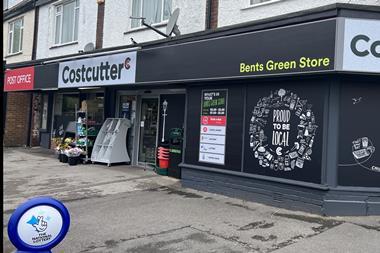As Colin Graves celebrates Costcutter’s 25th anniversary, he explains to Simon Creasey why he’s selling up to Bibby Line
For a man awaiting bad news, Colin Graves is in a remarkably ebullient mood.
It’s Monday 12 September and the chairman of Yorkshire County Cricket Club is bracing himself for confirmation his beloved team is about to be relegated from cricket’s top division.
It should be a hammer blow for the man who almost single-handedly rescued the club from financial oblivion a decade ago. But not even the cricket club’s fall from grace can dampen his spirits today, it seems. And that’s because the straight-talking Yorkshireman is celebrating a milestone involving the other passion in his life, retail more specifically, the symbol group Costcutter.
This evening, he will host a 25th anniversary exhibition and gala dinner in Birmingham for Costcutter retailers and suppliers, during which he will unveil a much-needed revamp of the traditional white fascia and the introduction of the new, upmarket myCostcutter brand.
And that’s not all. After special guest Shirley Bassey belts out a rousing rendition of ‘Big Spender’, the Costcutter chairman will announce that transport and logistics giant Bibby Line Group will sign a deal to secure sole ownership of Costcutter in the next six months.
It’s game-changing stuff from someone who once had a reputation for being inflexible when it came to new fascias, but as he explains in an exclusive interview with The Grocer beforehand thinking outside the box is critical in today’s challenging retail environment, as is securing the right investor to take the business forward.
To say Costcutter has come a long way in the past quarter of a century is an understatement. Graves launched it in the back room of his house, where suppliers actually stood in the kitchen ‘waiting room’ to chat to him. Today, the franchise business generates annual sales of almost £640m from its portfolio of just shy of 1,600 stores across the UK and Ireland. “It feels like I’ve climbed Everest 10 times,” he cheerfully admits. And this after attempting to scale the heights with another retailer.
Graves’ love affair with retail began 43 years ago when he landed a job at Spar. He worked his way up and by the age of 37 reached the position of sales director and secured a place on the Spar Guild board, but fell out of love with the business because he didn’t like the “internal politics” or the new convenience direction it was taking.
“When Spar went pure convenience eight till late it just abandoned the grocery side of the business,” claims Graves. “We weren’t competitive, we didn’t have the right range of products and we didn’t have strong enough promotions. We’d given in to the multiples.”
Graves was so disillusioned that he left to set up shop as an independent retail consultant. The timing of his departure was serendipitous, to say the least. “I’d grown up in the north of England with a lot of retailers who had built up big businesses turning over £30,000 to £50,000 a week, but you couldn’t run a business of that size on a convenience concept. Those retailers said ‘come and work for me Colin, point me in the right direction’. That’s where the concept for Costcutter came from.”
Graves admits he never thought the business would grow so quickly, but perhaps he shouldn’t be so surprised given the radical changes that have swept across the retail landscape over the past 25 years and indeed his career in grocery. “The way the retail market has changed and evolved in that time is unbelievable,” says Graves. “Tesco wasn’t even around 43 years ago, Asda wasn’t here and Sainsbury’s had just started out. I don’t think anybody will ever see as much change in the retail symbol group sector as I have.”
The most significant change has been the creation of central distribution deals, he says. “When I started Costcutter, the majority of retailers were dealing directly with suppliers, especially the bigger ones. The smaller ones were dealing with symbol groups. All that changed when central distribution came along. One of the big pluses of me joining Nisa was helping it to set up central distribution. That’s the biggest revolution that’s happened in our sector.”
But it’s the more recent emergence of a three-tier market that has prompted the business’s decision to launch the new myCostcutter fascia and revive Kwik Save. “In the symbol group sector there are three ponds and at the moment we’ve got one fishing rod,” explains Graves. “What we want to try and get is three different sets of bait for three different sets of retailers.”
The hope is that myCostcutter, with its modern black fascia, will sit at the top end of the market and compete with the likes of Waitrose and M&S, while Costcutter’s refreshed standard fascia will sit in the middle and Kwik Save, which it will bring back to the high street next year, will be aimed at the budget end of the market.
Costcutter MD Nick Ivel says the company is targeting about 100 myCostcutter stores to start with. The decision of which to convert will be largely based on location. “Some good stores out there turning over £40,000-£50,000 a week will keep the white fascia because of where they are,” says Ivel, adding that the new fascias will be supported with a revamped website that’s more “consumer-friendly” and that will one day lead to online ordering.
“It’s a big change for us when you add it to everything else,” he says.
The group has already registered a lot of interest from retailers who want to sign up for the new fascias, which will start rolling out early in the new year. Costcutter will be splashing the cash to ensure the venture is a success, adds Graves. “There’ll be a big investment,” he declares. “You can’t make a Mini look like a Rolls-Royce if you don’t spend any money on it.”
The investment has been possible thanks to the backing of Bibby, who acquired a 51% shareholding in Costcutter in 2007 and will wholly own the business within the next six months. Graves explains why he made the decision to offload the remaining stake.
“They’re a family investment business and one of the key divisions they want to invest in is retail. They’ve made that quite clear. Bibby want to expand and develop it and they want it to be the catalyst of the sector in the future. We could have sold it to one of our competitors but if we’d done that it would have been rolled into other companies and it could have got diluted.”
Graves insists that he and his team are very much part of Bibby’s plans for the business so much so that when the purchase eventually goes through the management team will sign contracts to work for Costcutter, with Graves at the helm.
The impact of Bibby’s ownership on Costcutter’s supply agreement with Nisa-Today’s remains to be seen. Graves refuses to be drawn on whether it will extend the deal, which expires in 2014, or seek alternative arrangements.
“By the middle of next year, we need to make up our mind about what we’re going to do. We’ve got about four options and we’re looking at them all. We’ve told our retailers to be patient there’s no urgency to do this. Nothing is going to change and the business is in safe hands.”
Given the challenges facing the c-store sector, a safe pair of hands is exactly what’s needed and what many retailers think Graves represents. As one whispers during the gala dinner: “He’s made a lot of people a lot of money long may it continue.”
Graves can at least be satisfied with his performance, then if not the Yorkshire cricketers’.
Sign in to comment on this article
Not logged in before? Register for FREE guest access today.
You will be able to:
- Read more stories
- Receive daily newsletters
- Comment on stories
Advert



















No comments yet